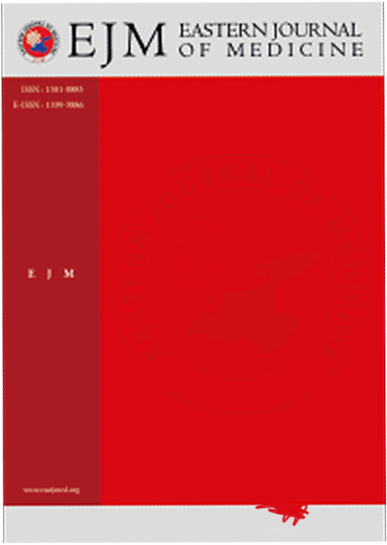Distribution and antibiotic susceptibilities of Stenotrophomonas maltophilia isolates detected in Ümraniye Training and Research Hospital
Yüksel Akkaya1, Ahmet Münir Yılmaz2, Begüm Nalça Erdin3, Ibrahim Halil Kılıç4, Zülal Aşçı Toraman51Department of Medical Microbiology of Hamidiye Faculty of Medicine, Health Sciences University, İstanbul, Türkiye2Emergency Medicine Clinic of Abdulkadir Yuksel State Hospital, Gaziantep, Türkiye
3Medical Microbiology Laboratory of Ümraniye Training and Research Hospital, University of Health Sciences
4Department of Biology of Faculty of Arts and Sciences, Gaziantep University, Gaziantep, Türkiye
5Department of Medical Microbiology of Faculty of Medicine, Fırat University, Elazığ, Türkiye
INTRODUCTION: The aim of this study was to determine the distribution of S.maltophilia isolates in hospitalized patients according to clinical and sample types and to reveal the antibiotic resistance rates of this organism.
METHODS: This study was conducted in the Microbiology Laboratory of Ümraniye Training and Research Hospital of Health Sciences University between 2021 and 2023. A total of 410 samples from 295 patients isolated from different samples from various clinics were included in the study. Bacterial identifications were performed by VITEK®MS device (Bio-Mérieux v.3.2, France) and susceptibility tests were performed according to EUCAST and CLSI recommendations.
RESULTS: S.maltophilia was detected in 149 patients in 2021, 66 patients in 2022 and 80 patients in 2023. In the study, isolates of the agents were detected in patients hospitalized in the Anesthesiology and Reanimation, Pediatric, Neonatal, Pediatric Cardiovascular Surgery and Internal Medicine intensive care units at rates of 30%, 16.3%, 15.4%, 13.2% and 4.6%, respectively. In tracheal aspirate, blood, catheter, peritoneal, biliary, wound and sputum samples of the patients, isolates of this agent were found in 48.8%, 23.7%, 8%, 2.7%, 2.7%, 2.7%, 2.7%, 2.4%, respectively. This agent was resistant to TMP-SXT, levofloxacin and ceftazidime at rates of 15.4%, 10.2% and 32.8%, respectively. In this study, it was determined that the number of S.maltophilia samples and the resistance rates of S.maltophilia to TMP-SXT, ceftazidime and levofloxacin increased gradually over the years.
DISCUSSION AND CONCLUSION: The importance of this bacterium is increasing due to the increase in the prevalence rates of S.maltophilia and TMP-SXT resistance rates against this agent.
Manuscript Language: English














